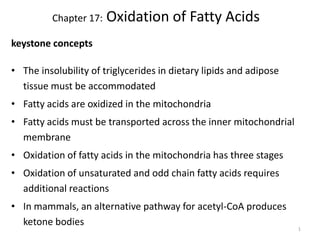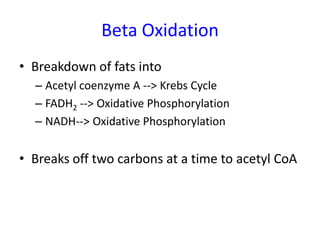Beta oxidation & protein catabolism
- 1. 1 Chapter 17: Oxidation of Fatty Acids keystone concepts • The insolubility of triglycerides in dietary lipids and adipose tissue must be accommodated • Fatty acids are oxidized in the mitochondria • Fatty acids must be transported across the inner mitochondrial membrane • Oxidation of fatty acids in the mitochondria has three stages • Oxidation of unsaturated and odd chain fatty acids requires additional reactions • In mammals, an alternative pathway for acetyl-CoA produces ketone bodies
- 2. Emulsification • Fats are not water soluble • Made soluble by bile salts (amphipathic) that are made in the liver and stored in the gall bladder • Converted to mixed micelles of bile salts and triacylglycerols
- 3. 3 How are dietary lipids processed?
- 4. Fat Metabolism I’m not fat, I’ve just got a lot of potential energy!
- 5. Fatty Acids and Energy • Fatty acids in triglycerides are the principal storage form of energy for most organisms. – Hydrocarbon chains are a highly reduced form of carbon. – The energy yield per gram of fatty acid oxidized is greater than that per gram of carbohydrate oxidized.
- 6. Beta Oxidation The break down of a fatty acid to acetyl-CoA units…the ‘glycolysis’ of fatty acids Occurs in the mitochondria STRICTLY AEROBIC Acetyl-CoA is fed directly into the Krebs cycle
- 7. Activation and Transported to Mitochondria • FA + CoA + ATP fatty acyl-CoA+ AMP + 2Pi • Coupled to the cleavage of ATP • AcylCoASynthetase– a family of isozymes specific for short, medium and long chain FA that catalyze production of fatty acyl-CoA • Transported through inner mitochondrial membrane via carnitine – uses specific acylcarnitine transporter
- 8. Beta Oxidation • Breakdown of fats into – Acetyl coenzyme A --> Krebs Cycle – FADH2 --> Oxidative Phosphorylation – NADH--> Oxidative Phosphorylation • Breaks off two carbons at a time to acetyl CoA
- 9. 9 -oxidation – first of three stages of fatty acid oxidation
- 10. 10 4 Steps of -oxidation 1. Dehydrogenation of the fatty acyl-CoA to make a trans double bond between α and β carbon. • Short, medium, and long chain acyl- CoAdehydrogenases • e- removed transferred to FAD 2. Hydration of the double bond 1. Dehydrogenation of the -hydroxyl group to a ketone - e- removed transferred to NAD+ 1. Acylation – addition of CoA and production of acetyl-CoA Step 1 Step 2 Step 3 Step 4
- 11. Energy Yield from -Oxidation • Yield of ATP per mole of stearic acid (C18). ATPStep Chemical Step Happens 1 2 4 Activation (stearic acid -> stearyl CoA) Oxidation (acyl CoA -> trans-enoyl CoA) produces FADH2 Oxidation (hydroxy- acyl CoA to ketoacyl CoA) produces NADH +H+ Oxidation of acetyl CoA by the common metabolic pathway, etc. Once 8 times 8 times 9 times -2 16 24 108 TOTAL 146
- 12. Ketone Bodies • Ketone bodies: acetone, -hydroxybutyrate, and acetoacetate; – are formed principally in liver mitochondria. – can be used as a fuel in most tissues and organs. • Formation occurs when the amount of acetyl CoA produced is excessive compared to the amount of oxaloacetate available to react with it and take it into the TCA; for example: – intake is high in lipids and low in carbohydrates. – diabetes is not suitably controlled. – starvation.
- 13. 13 ketone bodies: another fate for acetyl-CoA • Formed in the liver • Exported • Oxidized in citric acid cycle • Step 1: thiolasereversed – joins 2 acetyl-CoA • Step 2: acetyl-CoA condensation • Step 3: cleavage of acetyl-CoA • Step 4: reduction or decarboxylation
- 14. 14 ketone bodies provide energy
- 15. 15 Amino acid oxidation keystone concepts: • Dietary proteins - primary source of biologically useful N in animals • Amino groups transferred to α-ketoglutarate forming glutamate and an α-keto acid • Deaminated amino acids produce carbon skeletons that enter the citric acid cycle • Most amino acids are glucogenic, some are both glucogenic and ketogenic, just 2 are solely ketogenic
- 16. 16 amino acid oxidation • How much energy do organisms derive from amino acids? • That depends upon the organism Carnivores (~90% after a meal) Humans (10-15%) • What distinguishes amino acid catabolism from the oxidative processes discussed thus far? • Every amino acid contains an amino group; amino acid oxidation produces high quantities of toxin: Ammonia – NH4 +
- 17. N balance = Nin - Nout 1. AA are used for Protein Synthesis & N containing compounds 2. AA in excess are degraded (used for energy) N is disposed of in urea (80%) or creatinine
- 19. Negative Nitrogen Balance 1. Stress 2. Decreased Intake 3. Lack of an essential AA
- 20. 20 we cannot make essential amino acids
- 21. Metabolic Pool of Amino Acids • Metabolic pool AA has no storage form in mammals (as with other life forms) as free AA or as specialized storage form (such as glycogen for glucose, TG for FA) but a certain percentage of muscle & structural proteins are “expendable”. • AA are used for proteins, N compounds, energy (also via glucose) but increased protein breakdown will eventually compromise normal protein function. • Therefore need a small mobile pool of free AA in cells and blood
- 22. 22 Dietary protein is degraded to amino acids Proteases in the stomach and small intestine Peptidases at the intestinal mucosa
- 23. Protein Catabolism Overview of Protein catabolism.
- 24. 24 first step in amino acid oxidation • Removal of the amino group • Formation of an a-keto acid • How? • Aminotransferases (transaminases) • Collects the amino groups from many amino acids in the form of L-glutamate amino group carrier
- 25. 25 nitrogen excretion: urea cycle
- 26. Amino Acid Catabolism • The breakdown of amino acid carbon skeletons follows two pathways. – glucogenic amino acids: those whose carbon skeletons are degraded to pyruvate or oxaloacetate, both of which may then be converted to glucose by gluconeogenesis. – ketogenic amino acids: those whose carbon skeletons are degraded to acetyl CoA or acetoacetyl CoA, both of which may then be converted to ketone bodies.
- 27. Major Functions of Amino Acids Derived from Dietary Protein Oxidation Glycogenic amino acids: --Blood glucose--Energy Ketogenic amino acids: -Acetyl CoA-Stored fat-Energy Biosynthesis of nitrogen-containing metabolites Heme Blood cell Choline PL Glycosamine Sugar Nucleotides DNA Protein synthesis Protein Biogenic amines Neurotransmitters Carnitine Heart Creatine phosphate « Energy »
- 28. Amino Acid Catabolism • Catabolism of AA carbon skeletons.
- 29. Amino Acid Catabolism Glucogenic Aspartate Asparagine Alanine Glycine Serine Threonine Cysteine Glutamate Glutamine Arginine Proline Histidine Valine Methionine Ketogenic Leucine Lysine Glucogenic and Ketogenic Isoleucine Phenylalanine Tryptophan Tyrosine




























